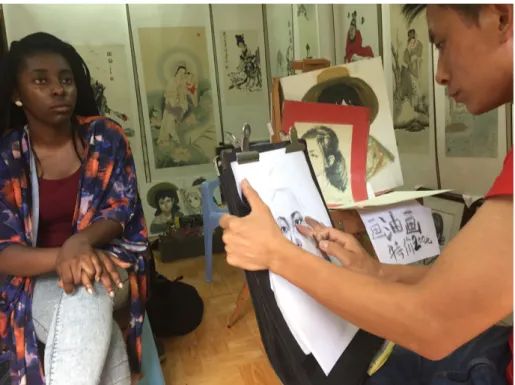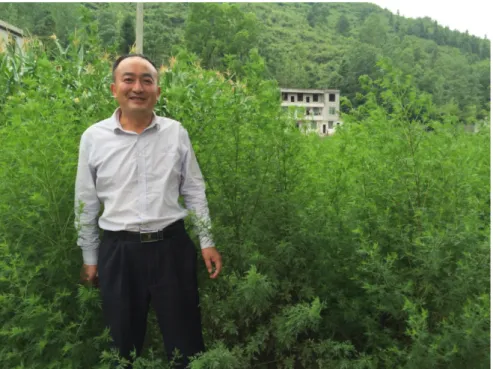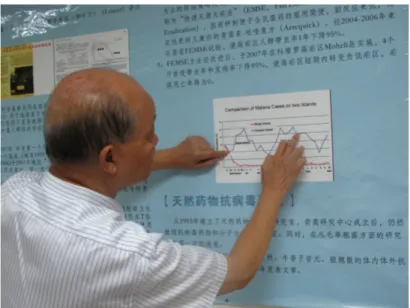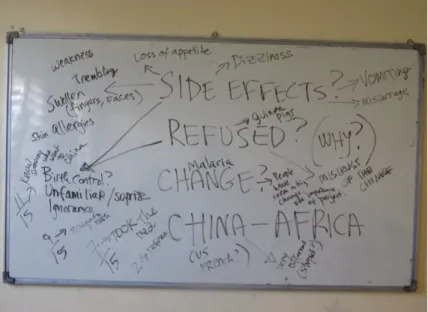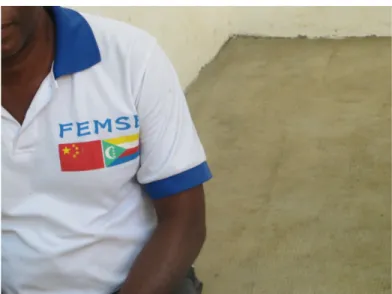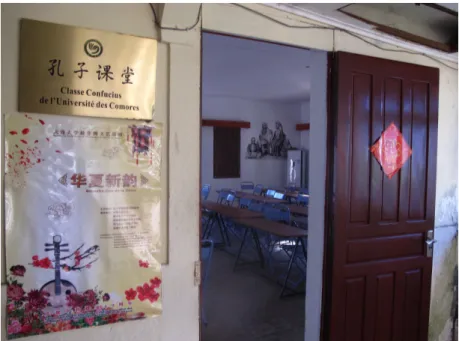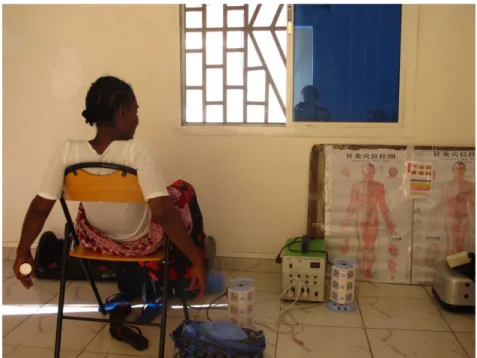HAL Id: hal-03210168
https://hal.archives-ouvertes.fr/hal-03210168
Submitted on 27 Apr 2021HAL is a multi-disciplinary open access archive for the deposit and dissemination of sci-entific research documents, whether they are pub-lished or not. The documents may come from teaching and research institutions in France or abroad, or from public or private research centers.
L’archive ouverte pluridisciplinaire HAL, est destinée au dépôt et à la diffusion de documents scientifiques de niveau recherche, publiés ou non, émanant des établissements d’enseignement et de recherche français ou étrangers, des laboratoires publics ou privés.
Kelley Sams
To cite this version:
Kelley Sams. China and the circulation of artemisinin-based malaria treatment in the Comoros Union. European Association of Social Anthropology, Jul 2016, Milan, Italy. �hal-03210168�
China and the circulation of artemisinin-based malaria treatment in the Comoros Union EASA Panel 136 : The Political Life of Commodoties Kelley Sams, Postdoctoral Researcher in Social Anthropology, Norbert Elias Center/EHESS, Marseille, France As soon as we arrived at the airport we were asked to take a pill. We asked for information about the origin of the product, and the only response that we were given was that it was a Chinese product to fight against malaria. We were accompanied by two expatriates from Sauve une Vie who had been in the Comoros for over a month, and were taking Malarone as prophylaxis. They refused to take the pill they were given at the airport, saying that they were taking prophylaxis. However, the agent in charge of the medication distribution did not allow them to enter the country and they were required to leave on the next plane. Taking this pill was a condition to enter the territory of Moheli. We were not able to see where these pills were manufactured nor their composition. We only knew that it was a Chinese product…Alice, 2008 In this email, Alice, a French employee of a Belgian NGO, describes an encounter with the malaria elimination program funded by the Chinese State in the Comoros from 2007 to 2015. This initiative, based on a strategy of the mass distribution of Chinese–produced artemisinin combination therapy, was lauded as a groundbreaking success by some, while being critiqued and countered by others. After eight years of implementation, the program succeeded in reducing the number of cases of malaria in the country from 100,000 to less than 1000 per year. However, in addition to having an impact on disease prevalence, the program also provoked ambivalent discussion about the threat and benefit of Chinese public health work in Africa; and impacted the imaginary of China both within the world of global health and the Comoros. The Nobel Prize in Medicine delivered for the discovery of artemisinin (青蒿素) to Tu Youyou in October 2015 was remarkable in at least two ways: first, never before has a development emerging from traditional Chinese medicine been recognized with such an important award, and second, this was the first time any researcher working in China has been selected for this prize. Artemisinin-based treatment for malaria has changed the face of disease treatment in sub-Saharan Africa, reducing deaths and provoking new regulations to control the medication’s use and availability. The research presented here emerges from a larger project examining the circulation of artemisinin-based medications in Africa and related social and political effects. As I was conducting fieldwork for this project in China, I often heard about how a group of Chinese doctors had eliminated malaria from a country in the Indian Ocean by using artemisinin. At first I was not sure how much truth there was to this story. Could this be possible? And with a medication that is supposed to be used for disease treatment and not prevention? Upon further investigation, I became struck with how the imaginary of China was engaged in the telling of this story. An internet search brought up articles with titles such as “China’s War on Malaria” (Meyer 2014), and “China Tests Malaria Drug on Entire African Nation” (Van Sant 2014).
In November 2015 I traveled to the Comoros to conduct ethnographic research with individuals who had received (or intentionally avoided receiving) medication from the program as well as with the medical professionals, politicians and other actors in public health. As I spoke with these individuals and learned more about the “social life” of the program, I became convinced that an analysis of the program’s implementation, results, as well as related clashes and controversies could provide important insight to the political and social effects of the circulation of medication and public health strategies in Africa. This paper presents an analysis of semi-structured interviews conducted in the Comoros, China, and Switzerland centered around the following two questions: In the Comoros Union that was under French rule until 1975, how is the growing Chinese influence on health care interpreted? What kind of alternative do new approaches to public health offer to individuals living within this post-colonial context? Studying China in Africa China’s increasing influence on the African continent has provoked much discussion and research in recent years as the flows of people and products between China and Africa produce new social and political impacts. Mathews investigates “low-end globalization” by studying the micro-level interactions of traders from Africa and other parts of the world in Hong Kong and Southern China (Mathews 2011). He writes “China’s movement into Africa represents a shift of global significance, as China increasingly replaces the West, and particularly Africa’s earlier European colonial masters, as sub-Saharan Africa’s major trading partner and patron” (2011:150). While Mathews describes the important scale of China’s relationship with sub-Saharan Africa, it is also important to understand how this is occurring, and in what ways this shift is different from a simple substitution of European political and economic power. Figure 1: A visiting student has her portrait drawn in Guangzhou, China
Alden (2007) identifies three competing views that scholars have taken on China’s role in Africa: as development partner, economic competitor, or colonizer. However, I take the position that the relationship is more complex than choosing any one of these three options: not only should we not reduce China to having only one type of relationship with Africa, but it is also misguided to focus on China as one unified entity, rather than as a flow of individual technologies, ideas and objects. The presence of China in Africa is felt in terms of large State-funded initiatives, but also through new imaginaries provoked by Kung Fu films, Traditional Chinese Medicine clinics, and personal relationships. Recent discourse on China-Africa relations, both in academic research and in popular culture, engage binary distinctions when comparing China to European powers. Again, I would like to highlight the need for an approach considering the multiplicity of forms and actors involved in these relationships. As other scholars have noted, the radical division between Europe and Asia that has become built into how we think about history is based on an emphasis of the importance of geographic boundaries rather than a comprehensive understanding of flows that have existed for centuries (Goody 2012; Tagliacozzo, et al. 2015). While circulation has been important for many years, there has been a major change of the scale of these flows during the second half of the 20th century. More than just a simple increase in the quantity and speed of circulation, we have seen societies become more interconnected, new relationships develop, and a reshaping of the socio-political imaginary. By studying the circulation of material objects, we can gain insight to the dynamic social systems that are engaged in these flows, and the exchanges that are beyond simply economic. As Appadurai and Koppytof (1986) suggest, objects experience “social lives” as they are exchanged and circulate along with ideas and relationships. It is these micro-level interactions with objects involved in large-scale circulation that provide the most interesting view of how globalization is lived, interpreted, and negotiated. Applied by scholars to study the “social life” of medications (Whyte, et al. 2002), this approach has not yet been applied to understand how a “hybrid” medicine like artemisinin-based malaria treatment, based on a traditional Chinese recipe, becomes reinterpreted by Western biomedicine and also acts as a vehicle representing China. ACTs and the Development of Artemisinin China’s role in African healthcare is becoming increasingly important through the State’s involvement in global health initiatives, donations of equipment and medication, construction of health facilities, and an increasing presence in the private market. Specifically addressing malaria, China pledged to build and supply 30 anti-malaria centers in sub-Saharan Africa, and donates medications to many countries (Brautigam 2009). China’s growing role in African health care coincides with its increased contribution to the international pharmaceutical industry through raw materials, new technologies, and finished products. The discovery of artemisinin came from a collaborative research project launched by Mao Zedong in 1967 (Jianfang 2013). This project, implemented by research
laboratories throughout the country, aimed to develop an effective treatment for malaria based on Traditional Chinese Medicine. Chairman Mao was driven with urgency to develop this medication as a way of supporting his communist allies being weakened by the disease during their fight against the American military in the heavily malaria-endemic areas of Vietnam. Researchers extracted artemisinin from the plant artemesia annua, frequently used in traditional medicine, and found it to be rapidly effective in treating malaria with few side effects. Figure 2: Farmer and his crop of artemesia annua in Chongqing, China The first artemisinin extraction plant opened in Chongqing, China in 1985. However, artemisinin-based medications did not enter the global market until Western pharmaceutical companies and the World Health Organization (WHO) became involved. Since 2001, WHO has recommended artemisinin-based combination therapies (ACTs) for the treatment of plasmodium falciparum malaria. These therapies are formulated with artemisinin added to one other active malaria-fighting ingredient such as lumefantrine, amodiaquine or piperaquine. While most of the artemisinin used to produce these medications still comes from China, the majority of ACTs available in sub-Saharan Africa are now produced by European and Indian manufacturers ACT has been referred to as an example of a “hybrid” medication: an industrial medication combining traditional Asian medicine and biomedical technology (Micollier 2013). When it first penetrated the antimalarial market in Africa, representations about this treatment centered on its “Chinese-ness”: a treatment that, while more expensive than alternative malaria treatments, was based on the natural harmony of plant-based medicines. Since that time, the identity of ACTs has been largely shaped by European and North American agencies involved in their dissemination and subsidization. The WHO maintains a list of “Prequalified” ACTs, approved for quality and manufacturing practices. Only one Chinese brand (Arusomoon) appears on this list, although many of the prequalified ACTs are manufactured in China with Chinese ingredients. Most health and development programs follow this WHO list and do not
purchase ACTs that are not included. However, observation in both informal and formal pharmacies shows that, in many African countries, ACTs are entering the market through alternative channels. One of these medications is Artequick, produced by Artepharm Pharmaceuticals headquartered in Guangzhou, China, and used in the Comoros Malaria Elimination program. This ACT, made with a combination of artemesinin and piperaquine was developed in partnership with doctors from the Guangzhou University of Chinese Medicine Artemisinin Research Laboratory, one of the original facilities that contributed to the discovery of artemisinin in the 1970s. Since the discovery of artemisinin, doctors from the laboratory have been exploring different ways of using the drug, with the goal of eventual malaria eradication through eliminating the disease-causing parasite. FEMSE Professor Li Guoqiao, the director of the Guangzhou laboratory, explained to me that, in his opinion, most malaria-elimination programs have engaged the wrong strategy: trying to eliminate the mosquitos that transmit the parasites responsible for malaria, rather than the parasites themselves. He stated, “you don’t need to kill the mosquito. That is too hard. You will never finish. It is quick and easy to kill the parasite that lives in the blood.” Professor Li began successfully testing this strategy in Cambodia in 2003, and decided to move the program to an African country in 2006. This is a very different strategy from current approaches to fighting malaria led by European or North American partners. A longtime friend and collaborator of Professor Li, the American doctor Keith Arnold, proposed the name FEMSE, Fast Elimination of Malaria through Source Eradication, for this strategy, and the team began to search for a new field site. During the search for a new site, a Chinese nurse who had lived in the Comoros for over five years contacted Professor Li. Although she did not personally know Professor Li, she had read about his work, and told him about the need for work to reduce the prevalence of malaria on all of the country’s three islands. The FEMSE program began mass distribution of Artequick on Moheli Island in 2007, followed by Anjouan Island in 2012, and Grande Comore in 2013. The distribution of the ACT was done by village volunteers going from house-to-house, as well as medical staff conducting distribution at airports, seaports, and schools. 4000 Comorien staff and volunteers and 38 Chinese doctors and students were involved in the implementation of this mass drug administration program that distributed over two million treatment courses of Artequick to the country’s 800,000 residents and visitors (Institute of Science and Technology 2014). WHO estimates that over 75% of the country’s population received treatment with Artequick, and most with two rounds of treatment following the FEMSE strategy guidelines (World Health Organization 2015).
Figure 3: Prof Li shows the results of the Comoros FEMSE program From 2007 to 2015, the country saw a 95% reduction in cases of malaria However, some scientists and public heath experts critique the FEMSE program for contributing to artemisinin resistance, decreasing immunity to the disease, and for the inclusion of primaquine in the medication, and ingredient that may be fatal to individuals with a deficiency of the enzyme G6PD. An article published in the Economist cites the country’s then Minister of Health, Fouad Mhadji, as dismissing these critiques as mainly “fueled by competition between Western and Chinese pharmaceutical companies” (The Economist 2014:4). Hope and Distrust Resistance to FEMSE’s mass drug distribution was not only due to scientific critique of the program. As we saw in Alice’s description of her encounter at the beginning of this text, the way that the drug was administered with little explanation allowed for the creation of diverse representations of the medication’s and the program’s purpose. Some individuals interpreted the strategy as China testing potentially dangerous new drugs on a vulnerable population or as a new method of birth control. To counter these interpretations, local health care providers and officials held public meetings or made announcements. One local doctor in Grand Comore is described as encouraging his community to take the medication by shouting through a megaphone, “This drug is safe and effective. You are not being used as Guinea pigs.” (The Economist 2014:3). During my interviews with people who avoided consuming Artequick during the mass distribution, reasons for not wanting to take the drug focused around the potential for unknown side effects or often the origin of the medication. “I didn’t take it because I’m not used to those kinds of medicines.” the wife of one of the Comorian FEMSE staff who had refused the medication told me. Upon prodding, she explained what she meant by “those” kinds of medicines: “Medicines from China. They are not made for us. They may work there, but we don’t know what they will do to our people.”
Figure 4: Notes from a focus group discussion in Moroni about FEMSE and China-Africa relations This interview came right after lunch. After eating, her husband Hassan had walked to the mosque and left his wife and I sitting side-by-side on the brown couch with our empty plates on the coffee table in front of us. Her distrust of the medication surprised me, especially after her husband had just spoken to me for hours about the superiority of Artequick over other malaria medications and his confidence in the success of the FEMSE program. When I asked her about this, she said that at first Hassan was hesitant too, but after spending so much time with the Chinese medical doctors, he had learned two things: 1. Artequick and the FEMSE strategy are the most effective way of eliminating malaria; 2. The Chinese do not think about health or work like “other people”. Interlocutors also highlighted the different approach of the FEMSE program. While many admitted being shocked at first by the program’s mass distribution method, which was described as, at times, quite forceful, there was a consensus that, like the medication, the Chinese approach was something that one could “get used to”. However, the ambivalence felt toward Chinese initiatives in the Comoros was quite clear. On one hand, China, an official partner of the Comoros since the day of the country’s independence, over forty years ago, offers an alternative way of doing things. This is often contrasted with what has been historically proposed by France. Yet, on the other hand, the exact alternative being offered is not clear. Sometimes China was seen as a new colonial power, and a producer of low quality potentially dangerous goods, but other times China was seen proposing a model of development that was adapted and empowering for Comorians, even if it took some time to become accustomed to.
Figure 5: A former driver from the FEMSE program wearing a shirt with the logo of the flags of China and the Comoros Rachid, a pharmacist in Anjouan, explained to me, “The Comoros was French until 1975. Before that it was English, and Portguese, and Arab. Maybe we will become Chinese next, who knows? No, I’m kidding. But really, the Chinese ambassador in Comoros has a strong weight. Before, it used to be the French embassy, but you can see that it is changing. Comorians are tired of the French way of doing things. The Chinese have built buildings, hospitals. They are able to do deep sea fishing, which Comorians don’t have the technology to do. However, among educated Comorians, there is still a distrust of Chinese medications. Even if it’s not politically correct, they will look for medicines made in France. It’s true that a lot of the counterfeit medications come from China. But the Chinese “respect internal affairs”. They have done so many things: built roads, palais de peuple, the water system in Moroni, most recently they have eliminated malaria.” The growing demand for Mandarin language classes, traditional medicine services, and collaborations with Chinese cultural offerings shows this growing interest in the future that China has to offer. While I was conducting fieldwork in the Comoros, I attended two Mandarin Chinese classes. These classes, led by university professors from Northern China who had been sent to work in the Comoros for two years, were filled with students. After the classes I spoke with these students, many of them also attending university classes, about their reasons for studying Chinese. They often claimed that China presented a unique potential opportunity that they were open to discovering. “We’ve already had our experience with the French” Siti, a 23 year old student who was also studying engineering at the university told me, “We want something new.”
Figure 6: Confucius Classroom before class in Moroni A lot of resentment and blame is put on France for the Comoros’ current state of development. Siti continued, “All countries that were colonized by France are now underdeveloped. These are the countries that are in war, that have problems with security. For example, other countries, like those colonized by the British, they got out of it okay. The Seychelles, Mauritius…” These feelings about the country’s past colonial history influenced the context for Chinese initiatives such as the FEMSE program. French influence was also given as a reason for some individuals to refuse the medication distributed by the FEMSE program. Only 74% of individuals on the island of Grand Comoros accepted the medication, compared with 95% on the other two islands. This was explained to me by Hassan, an employee of the Ministry of Health Malaria Program, as partially being motivated by the close ties that Grand Comoros has with France, “The French didn’t like this project at all. Even when the FEMSE team came to l’école française of Moroni, they were turned away. Not like the other schools, who welcomed them. I think the French don’t like to see the Chinese succeeding where they have failed. They tried many things in this country, but the Chinese achieved something that they couldn’t.” China is seen to offer a development model that is very different from European (post-) colonialism. Instead of wanting to control places outside of their own country, interlocutors told me during interviews, the Chinese have other specific objectives. “China has had too much experience with foreign invasion. It does not colonialize. The Chinese started going into the Indian Ocean on ships a long time ago, but they did not colonize. It was to do business and trade, and then to go back home.” The FEMSE program, implemented by the Comorian Ministry of Health in collaboration with Chinese partners, was seen as a remarkable concrete example of how China may contribute to the Comoros. Unlike other public health programs, where program activities may become more important than program identities, FEMSE and Artequick were always analyzed in terms of being Chinese. Both positive and negative perspectives of the program and medication where positioned in terms of cultural identity. The
medication and strategy of the program were often critiqued and these fears were positioned in terms of the potential motivations of the Chinese government as well as the ingredients and quality of the medication. Although the Chinese offer what are seen as promising opportunities, many things about these opportunities are unclear. The FEMSE program was seen as something difficult to understand, but possibly very positive, there was a lot of misunderstanding of other Chinese initiatives in the country. This was seen in the discourse surrounding the donation of diverse Chinese-produced medications to health facilities, or the hopeful confusion with which the Chinese medicine clinics in the country were met. Hali, who sells cloth at a market stand located directly across from a Chinese medicine clinic compared Chinese initiatives like FEMSE with Chinese traditional medicine, “We were not sure it would work. The machines and medicines are strange with their medicine, but you try, and maybe it will be better than what you’ve tried before, or maybe it won’t do anything at all. We tried, and this one worked.” Figure 7: Private Chinese medicine clinic in Moroni Conclusion The FEMSE program and the distribution of Artequick, were understood and positioned within a context that had ambivalent but strong perceptions about China. On one hand, China was seen as offering a promising alternative to post-colonial French and British approaches to development, and Chinese medicine embraced as offering a “natural”, possibly effective, alternative to biomedicine. However, on the other hand, Chinese products are often seen as inferior, and Chinese-produced counterfeit medications have received recent attention as an African public health threat (Sambira 2013). Artemisinin-based medication, as a “hybrid” biomedicine, lies at the crossroads of Traditional Chinese Medicine and “Western” Biomedicine. When European-produced
ACTs circulate, the Chinese aspect of their identity becomes minimized in favor of a biomedical aspect. The FEMSE program, seen as being unique in its “Chinese-ness”, highlighted the Chinese aspect of the ACT Artequick, and the mass distribution strategy for malaria elimination. The alternative approach to public health offered by the Chinese carries along with it negative perceptions and hesitation about the quality and motivation of China, but also great hope in a new approach to eliminating disease and improving life in the Comoros.
Works Cited: Alden, Chris 2007 China in Africa. London: Zed Books. Appadurai, Arjun 1986 The Social Life of Things: Commodities in Cultural Perspective: Cambridge University Press. Brautigam, Deborah 2009 The Dragon's Gift: The Real Story of China in Africa: Oxford University Press. Goody, Jack 2012 The Theft of History: Cambridge University Press. Institute of Science and Technology, Guanzhou University of Chinese Medicine 2014 FEMSE: Fast Elimination of Malaria by Source Eradication: Artepharm. Jianfang, Zhang, ed. 2013 A Detailed Chronological Record of Project 523 and the Discovery and Development of Qinghaosu (Artemesinin): Strategic Book Publishing and Rights Co. Mathews, Gordon 2011 Ghetto at the Center of the World. Chicago: University of Chicago Press. Meyer, Eric 2014 China's War On Malaria: A Tiny Nation Pushed Into A Test-Tube. In Forbes, Vol. 2016. Forbes Asia. Micollier, Evelyne 2013 Nouveaux Produits de la Pharmacopée Chinoise Contemporaine : R&D, Definition et Socialite en Reseaux Autrepart (1):69-88. Sambira, Jocelyne 2013 Counterfeit drugs raise Africa’s temperature, Vol. 2016: United Nations AfricaRenewal. Tagliacozzo, Eric, Helen F Siu, and Peter C Perdue 2015 Asia Inside Out: Changing Times: Harvard University Press. The Economist 2014 Cure All? In The Economist, Vol. 2016. Van Sant, Shannon 2014 China Tests Malaria Drug on Entire African Nation, Vol. 2016: CBS News. Whyte, Susan Reynolds, Sjaak Van der Geest, and Anita Hardon, eds. 2002 Social Lives of Medicines: Cambridge University Press. World Health Organization 2015 Malaria Policy Advisory Committee Meeting: 16–18 September 2015, Geneva, Switzerland Background document for Session 1.
